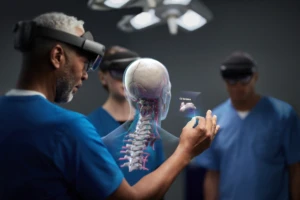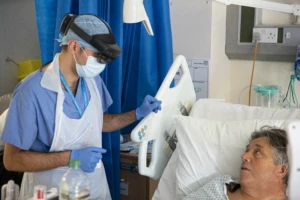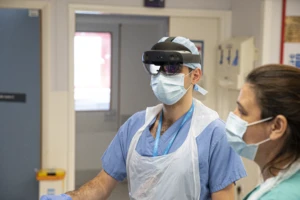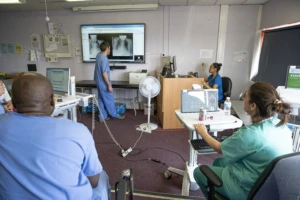
What’s next: How can other NHS Trusts get involved?
 This is a part of a series of posts about how the HoloLens and Dynamics 365 Remote Assist helps the NHS provide patient care. See the other blog posts here.
This is a part of a series of posts about how the HoloLens and Dynamics 365 Remote Assist helps the NHS provide patient care. See the other blog posts here.
We have seen significant experimentation with HoloLens 2 in health since we launched it back in 2015. Much of that work has been around doctors piloting within the advanced visualisation, pre-operative surgical planning, multidisciplinary team scenarios, patient education, and medical training to name a few.
Since 2015’s launch of HoloLens 1, the feedback from our Development Kit has been used to inform the development priorities of HoloLens 2. We designed HoloLens 2 to be more immersive, comfortable, and to help companies get started with out of the box applications for quicker time to market.
With the launch of HoloLens 2, we now have significant out of the box applications that include Dynamics 365 Remote Assist and Mixed Reality Partner applications. We have great examples for What HoloLens 2 Can Do today across industries, and how we can use these to transform health tech.
Continuing to prioritise remote assist scenarios across the NHS
My favourite starting point for the NHS Trusts is within remote assist scenarios. Previously, we talked about how remote assist started as a tool to help protect Imperial College NHS Healthcare Trust staff while delivering on patient care during COVID-19. It started in a few wards such as respiratory and has now been extended into renal and trauma wards. It’s also being used for undergraduate and graduate training scenarios across many Trusts.
The technology was applied in both adult and paediatric settings. It’s been used in open areas such as clinics/ward and confined areas such as operating theatres. Across many Trusts, it’s assisted during delivery-intense clinical service such as surgery, to teaching for undergraduate and graduate training scenarios.
We also are seeing the potential applications and pilots are in process right now for distributed geographic care and primary care scenarios.
There is a great opportunity to connect HoloLens 2 and Dynamics 365 Remote Assist to Electronic Health Records. By doing so, we can leverage tools such as Power Platform, Dynamics 365 Customer Service, and Dynamics 365 Field Service. This means we can ensure we provide the right information at the right place and time, with the right data governance structures.
Expanding use cases with mixed reality partners
There’s more to HoloLens 2 than remote assist. We also have significant interest from NHS Trusts to work with partners. Here are some examples we are seeing from our innovative partners:
Case Western Reserve University has built a HoloAnatomy curriculum. In a Medical Science Educator journal study, students using HoloAnatomy required 40 percent less classroom time to cover the required learning than those doing dissection. This year, they sent 185 HoloLens to their first year medical students so they could keep studying. We’re seeing others, including Oxford University, looking to bring this to the UK.
ApoQlar has been building a Virtual Surgery Intelligence platform that is being used by various hospitals around the world – from Marien Krankehaus to the Newcastle upon Tyne Hospitals NHS Trust. Offerings include Surgery, Surgery Planning, Telemedicine, Documentation, Patient Education, and Teaching applications. The platform uses AI to segment and present MRI and CT scans in 3D.
Medivis has been building out a SurgicalAR and AnatomyX platform for healthcare. SurgicalAR is building the future of computer-assisted surgery by harnessing HoloLens and AI. It aims to improve surgical outcomes for patients and drive cost savings for medical institutions.
Philips is building Azurion, an image-guided therapy platform for minimally invasive surgery. It brings live imaging and other sources of data into a 3D holographic augmented reality environment. This can be ergonomically, easily, and intuitively controlled by the physician.
GigXR HoloPatient is a suite of standardised holographic simulations for safe and practical instructor-led development of clinical skills. Trainees can see, hear, and assess holographic patients with new pathologies that exhibit varied symptoms. They can easily see presentations of different illnesses or injuries.
ResilientXR is a partnership between digital creative industry, academia, and government. Made up of Microsoft, Dimension, Digital Catapult, VISR-VR, Fracture Reality, Make Real, University of Leeds’ Centre for Immersive Technologies, and University College London. The ResilientXR consortium identified immediate training needs for clinical staff during COVID-19. Within a few weeks, they developed and deployed to HEE interventions to meet these needs. This includes 2D videos, volumetric holographic videos, resources, and an immersive platform for management and global distribution of the XR content across devices.
In addition, we are working to onboard new partners such as Medical iSight, into our Mixed Reality Partner Program. The team at Medical iSight has had extensive experience with HoloLens since 2018. This has been invaluable to the current speed of deployment with existing use cases. Going forward, Medical iSight is developing a comprehensive platform for surgical planning, image-guided intervention, healthcare education, and remote clinical collaboration. In particular, it has a bespoke module for interventional neuroradiology, where live 2D imaging is spatially registered to pre-operatively acquired 3D scans, used during mechanical thrombectomy for the treatment of strokes.
Building the evidence base to measure effectiveness
As a collective, we have an opportunity to drive a structured approach for wider trials to continue to demonstrate impact in a transparent and robust way, both for the Dynamics 365 Remote Assist use case and for new use cases. We can share learnings and insights, including how we scale this out on a national and global basis.
Working with the NHS Trusts as a collaborative community
 Insight are one of our key mixed reality partners, and also an authorised reseller of HoloLens 2. They can help advise on solutions and also has a practice to do custom development.
Insight are one of our key mixed reality partners, and also an authorised reseller of HoloLens 2. They can help advise on solutions and also has a practice to do custom development.
Insight has packaged the best practices and created a free Dynamics 365 Remote Assist Fast Start for NHS organisations who purchase HoloLens 2 through Insight.
Once you get set-up through this process, we will look forward to integrating you into the NHS Teams collaboration site that we have, for community Q&A and in sharing best practices.
Three years of innovation in three months, but let’s keep going
As I reflect on the past three months (which feels like a lifetime ago now!), I am deeply impressed with the work being done. With the NHS Trusts, I believe we have done something very profound in proving that we can get HoloLens 2 and Dynamics 365 Remote Assist deployed. The evidence proves that this technology can help protect NHS staff lives, while delivering new models of remote patient care.
We are still in the early days of tapping into the vast potential of HoloLens. However, we are already seeing more use cases being adopted by more NHS Trusts, social care, and medical schools.
With leadership from our leading clinicians within the NHS, our opportunity will be to continue to work as a collective with our partners like Insight, Medical iSight, and our mixed reality partners and deliver the full potential of this transformative technology.
Find out more
How HoloLens and Dynamics 365 Remote Assist helps the NHS provide patient care
Defining and implementing Dynamics 365 Remote Assist use cases
Measuring patient and clinical effectiveness
What technology is needed to get started
About the author
 Leila has been working on the commercial mixed reality business for the last five years and is based in the UK. She’s been working with some of the most advanced customers and partners in the world, helping them identify, pilot and deploy technologies that have a profound ability to transform their business.
Leila has been working on the commercial mixed reality business for the last five years and is based in the UK. She’s been working with some of the most advanced customers and partners in the world, helping them identify, pilot and deploy technologies that have a profound ability to transform their business.
Prior to joining the mixed reality team, she held several senior positions at Microsoft including leading consumer and commercial business units such as Server & Tools and Windows in the UK and Central & Eastern Europe.




